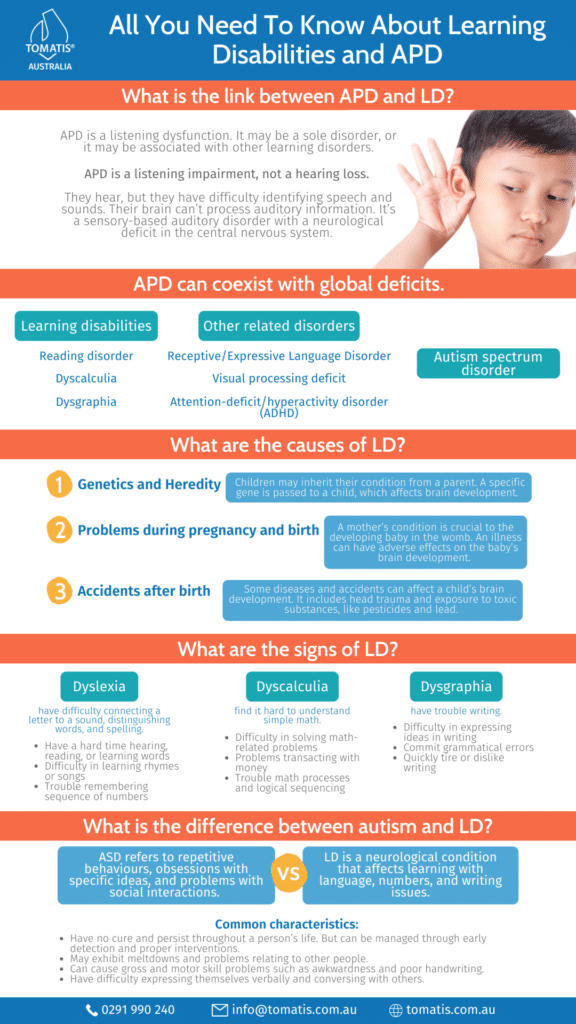Auditory Processing Disorder can be related to Learning Disabilities that hinder holistic development. Distinguishing these two complex conditions and bring better awareness to concerned individuals about Auditory Processing Disorder and Learning Disabilities is important because these two are often interconnected with each other
At Tomatis® Australia, we aim to inform people of the issues that arise that may be present in your child. Let us share with you the differences and similarities between Learning Disabilities and APD.
What is the relationship between Learning Disabilities and APD?
APD is a listening dysfunction. It may be a sole disorder, or it may be associated with other learning disorders.
APD is a listening impairment, not a hearing loss. People with APD have normal hearing structures of the inner, middle, and outer ear. The structures function properly. They hear, but they have difficulty identifying speech and sounds. Their brain can’t process auditory information. It’s a sensory-based auditory disorder with a neurological deficit in the central nervous system.
APD causes not all communication, language, or learning problems. An audiologist diagnoses APD, while multidisciplinary medical professionals assess global deficits. But APD can coexist with global deficits.
- Learning disabilities: Reading disorder is a learning or academic skills disorder. It’s a condition where a person can’t read with accuracy, understanding, and speed. Also called dyslexia, a person has difficulty reading, spelling, and writing. It’s the most common and acknowledged learning disability.
Dyscalculia refers to difficulty in learning math. A person has problems counting, calculating, measuring, counting money, and telling time. Anything to do with numbers is a challenge. It includes mental math and solving math equations.
Dysgraphia refers to difficulty in learning how to write. It involves physical writing with the use of the fingers and constructing written ideas. A person may display an awkward grip of a pen and trouble forming letters or shapes. Or having a hard time organising thoughts and having lapses in grammar and syntax are also signs of dysgraphia.
- Other related disorders: Receptive/Expressive Language Disorder, a non-verbal learning disability, is challenging to communicate appropriately. There’s a problem in receiving, sending, processing, and understanding concepts. May this be verbal, nonverbal, or visual. There are various types of communication disorders. These include disorders in speech, articulation, fluency, voice, and language.
Visual processing deficit refers to a difficulty in interpreting visual information. It involves various features such as visual discrimination, sequencing, and spatial relationship. People may not distinguish shapes from a background or see the order of images and words.
Attention-deficit/hyperactivity disorder (ADHD) refers to behaviours marked by distractibility, hyperactivity, and inattention. People with ADHD are impulsive and have problems focusing on a task. It can be attributed to a brain injury, preterm delivery, and low birth weight. It may also be caused by the tobacco and alcohol use of the mother during pregnancy. It’s the most common neurodevelopmental disorder of children.
- Autism spectrum disorder, a developmental disability of learning, thinking, and problem-solving skills, are either poor or excellent. People may act, communicate, and learn differently. They may have difficulty interacting, adapting to changes, and managing their emotions.
ASD had been linked to autism based on the Simons Simplex Collection autism project. The study shows 65% of children with autism had sensitivity to noise. The latest research reveals that 93% of adolescents with autism had trouble filtering noise.

What are the causes of Learning Disabilities (LD)?
Many factors can cause LD, and there are risk factors that predispose a child to develop LD. An element may be a sole cause, or it may include other factors that play a role in the development of LD.
- Genetics and Heredity: Children may inherit their condition from a parent. A specific gene is passed to a child, which affects brain development. An example of this condition is Fragile X syndrome. Other syndromes such as Down’s and Turners are associated with chromosome abnormalities.
- Problems during pregnancy and birth: A mother’s condition is crucial to the developing baby in the womb. An illness can have adverse effects on the baby’s brain development. An example is an autoimmune disease in women. A study found that maternal antibodies (anti-Ro/La) can affect the fetal brain of male babies.
Complications can occur during childbirth, such as prolonged labour. It causes a lack of oxygen to the child’s brain. The baby may also suffer a degree of brain impairment when born prematurely or underweight.
- Accidents after birth: Some diseases and accidents can affect a child’s brain development. It includes head trauma and exposure to toxic substances, like pesticides and lead. Babies born to neglectful parents may develop LD due to malnutrition and lack of mental stimulation.
What is the connection between fetal alcohol syndrome and Learning Disabilities (LD)?
Other than the health of the expectant mother, her habits during pregnancy also affect her unborn child. Studies show that mothers who drink alcohol gave birth to babies with fetal alcohol syndrome (FAS). Babies with FAS will, later on, have problems with learning, communication, vision, and hearing.
Like alcohol, drugs, and other toxic substances taken by the mother have harmful effects on the baby in the womb. The physical consequences of drug use include birth defects, respiratory failure, seizures, and brain damage.
Babies born from drug-dependent mothers suffer from developmental problems, such as learning disabilities. Studies show that babies born from mothers who abused cocaine had smaller heads indicative of lower IQ. Worse, babies may be stillborn, or there is a greater risk of sudden infant death syndrome if the baby lives. Developmental delays are also evident among babies whose mothers smoked marijuana.
What are the signs of Learning Disabilities (LD)?
There are many signs of learning disabilities, which depends on the specific condition. The three most common learning disabilities have the following signs you can easily spot:
- Dyslexia: People with dyslexia have difficulty connecting a letter to a sound, distinguishing words, and spelling. Some of the signs include:
-
- Have a hard time hearing, reading, or learning words
- Difficulty in learning rhymes or songs
- Trouble remembering sequence of numbers
2. Dyscalculia: People with dyscalculia find it hard to understand simple math.
-
- Difficulty in solving math-related problems
- Problems transacting with money
- Trouble math processes and logical sequencing
3. Dysgraphia: People with dysgraphia have trouble writing.
-
- Difficulty in expressing ideas in writing
- Commit grammatical errors
- Quickly tire or dislike writing
What is the difference between autism and Learning Disabilities (LD)?
Autism spectrum disorder (ASD) and LD are two distinct conditions based on the Diagnostic and Statistical Manual of Mental Disorders (DSM-5) of the American Psychiatric Association. However, ASD can affect learning, such as language skills.
A child with ASD can have a learning disability. However, not all children with a learning disability have ASD. ASD refers to repetitive behaviours, obsessions with specific ideas, and problems with social interactions. In contrast, LD is a neurological condition that affects learning with language, numbers, and writing issues.
Even if ASD and LD are different conditions, they share common characteristics.
- Both conditions have no cure and persist throughout a person’s life. But can be managed through early detection and proper interventions.
- People with both conditions may exhibit meltdowns and problems relating to other people.
- Both conditions can cause gross and motor skill problems such as awkwardness and poor handwriting.
- People with ASD and LD have difficulty expressing themselves verbally and conversing with others.
It’s Okay, Tomatis® Australia Is Here To Help.

Does your child have ASD and LD? It is best to seek consultation from a psychologist, educational therapist, and speech-language pathologist. Or you can call us at Tomatis® Australia at 1300 233 572 and speak with Francoise Nicoloff.
Françoise Nicoloff
Official Representative of Tomatis Developpement SA in Australia, Asia and South Pacific, Director of the Australian Tomatis® Method, Registered Psychologist, Certified Tomatis® Consultant Senior, Tomatis® International Trainer and Speaker, Co-author of the Listening Journey Series, 40 Years of Experience, Neurodiversity Speaker



